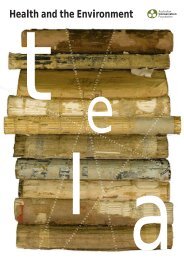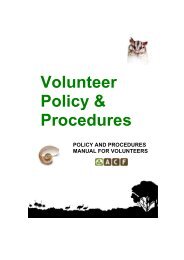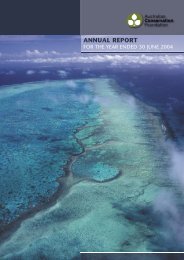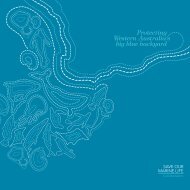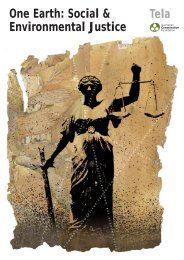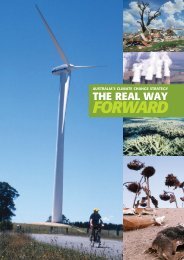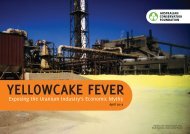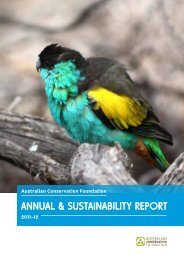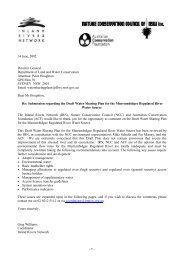pdf of habitat - Australian Conservation Foundation
pdf of habitat - Australian Conservation Foundation
pdf of habitat - Australian Conservation Foundation
- No tags were found...
Create successful ePaper yourself
Turn your PDF publications into a flip-book with our unique Google optimized e-Paper software.
general banter. The kids are camp children and everyone looksout for them. Laughter, guitar and song float in the air.At our final camp we are in for a cinematic treat. Warmed bycampfire, the surrounding bush providing our soundtrack, wewatch two films connected to this living country. The first film isabout Frans and his extraordinary path to joining the Goolarabooloo.The other is about Butcher Joe Nangan, an artist, who inthe seventies set about recording the traditional law and storiesto stem the effect <strong>of</strong> disruption from settlement. The film featuresButcher Joe’s ‘Mayarda’ (pelican dance). The pelican is the symbol<strong>of</strong> the Goolarabooloo.The following evening my friend and I find ourselves trailingPhillip Roe, grandson <strong>of</strong> Paddy Roe and senior law man, singing‘Mayarda’ as he leads our way down to a fire by the river. It was aclear expression <strong>of</strong> Le-an, connection <strong>of</strong> living culture and country,the unity <strong>of</strong> past, present and future. We gathered around thefire for corroboree sharing dance, music, song, laughter and sadnessfor the challenges faced by the Goolarabooloo people andothers caring for country.I lie with my back warmed by the yellow earth gazing up atthe stars.How different from our first night on trail. We walked alongCable Beach, guided by moonlight to camp at Ngunungurrukun(Coconut Wells). I was still plugged in; my mobile had a signal,I was aware <strong>of</strong> the 24-hour time clock and we talked loudly andwith intent about our busy ‘normal’ lives as we strode across thebeach. A beach fire led us to camp and we slowly unpluggedfrom our daily lives.We camped one night at Walmadan (JamesPrice Point), the proposed site for Australia’slargest gas hub. Camped among the dunes, thebright lights <strong>of</strong> Woodside’s drilling rigs lightingour horizon and filling the air with industrialnoises. It was stark contrast to earlier campsand though little was said it was felt acutely.We camp at Ngunungurrukun (CoconutWells), Nuwirrar (Barred Creek), Kardilakan (Quandong Point),Walmadan (James Price Point) and Bindingankun (Yellow River).The mother tongue <strong>of</strong> our country rolls awkwardly across mine. Iam more likely to understand an international dialect and I hopeto make this change.My fingertips rest in warm sand, the footsteps <strong>of</strong> thousands<strong>of</strong> years <strong>of</strong> walking this country imprinted in the grains <strong>of</strong> ourancient land. Stars wink above me. Each intake <strong>of</strong> breath is theair <strong>of</strong> all living things that have gone before me and are part <strong>of</strong>each <strong>of</strong> us now. I can hear the song cycle <strong>of</strong> this living country;my beautiful home.If you are interested in walking the Lurujarri Trail withus in June 2013, for an initial expression <strong>of</strong> interestplease email a.rutter@acfonline.org.au with “LurujarriTrail 2013” in the subject line.www.goolarabooloo.org.au/lurujarri.htmlPaddy RoeArtist:Jeanne BrowneA short gust <strong>of</strong> windblows in the light <strong>of</strong>day, a feature <strong>of</strong>Barrgana, winter.In 1931 Paddy Roe, a Njikina man, enteredJabirr Jabirr land with his woman Pegalilly. Itwas inhabited by 60 to 100 elderly people, includingWalmadany, the greatly respected king<strong>of</strong> the remnant Jabirr Jabirr tribe.The young people had been taken awayto missions, in accordance with our government’s‘native’ policy. There were no women <strong>of</strong>child-bearing age. Walmadany and the old lawkeepers Narbi and Kardilakan had been entrustedwith full custodianship <strong>of</strong> the lands <strong>of</strong> the JabbirJabbir, Ngumbarl and Minyirr Djugun people,which were overlain by station leases.Walmadany, Narbi and Kardilakan realisedthat without children it would be impossibleto care for the land. Within months <strong>of</strong> enteringJabirr Jabirr land, Pegalilly became pregnant.Narbi perceived that the spirit children, whohad been waiting to enter her but unable to doso because <strong>of</strong> her advanced age, had come to lifethrough Pegalilly.The Jabirr Jabirr elders examined Paddy Roe,walking him through the land. He was given fullknowledge <strong>of</strong> the place names, songs and stories<strong>of</strong> the land and made Keeper <strong>of</strong> the Law <strong>of</strong>the Jabirr Jabirr, Ngumbarl and Minyirr Djugunpeoples. He was later to bury many <strong>of</strong> thesepeople in their country. Paddy Roe settled hisfamily north <strong>of</strong> Broome, establishing the Goolarabooloocommunity.Joseph Roe, Paddy’s grandson, is now LawBoss and custodian for the Northern Traditionand the Goolarabooloo people. Joseph is joinedby Phililip Roe and Richard Hunter, Paddy’sgrandsons, as senior law men <strong>of</strong> the Goolarabooloopeople.For the full Songlines article,including photo galleries,video and Dreamtime storiesdownload the <strong>habitat</strong> iPadmagazine at the App Store.SonglinesJoseph is responsible formaintaining continuity <strong>of</strong> thesongline, including keepingthe coastal land clear <strong>of</strong> any developmentthat would interferewith their law and culture,or damage their song cycle.<strong>habitat</strong>9



